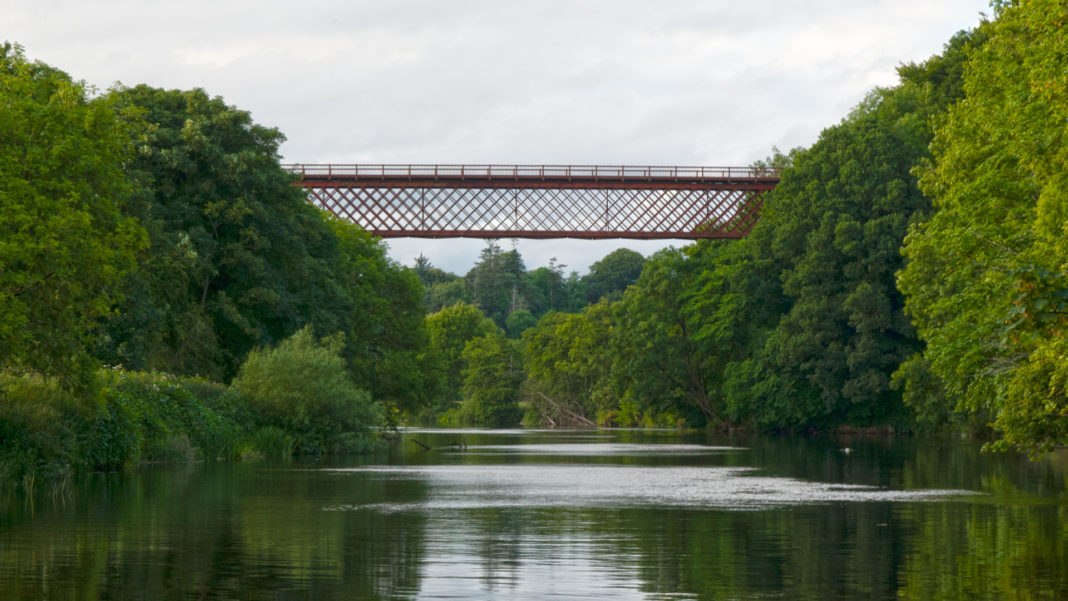It was still warm up on the viaduct last Saturday at dusk, and darkness was gathering behind the ruined tower of Carrickabrick Castle. Across the river, over the grassy path where trains once roared on their daily journey, away to the west and north, the sky was silver-blue, streaked with clouds of gold and pink and purple slate-grey.
Looking down at the Blackwater from that great height, the river’s surface was incredibly still, almost uniformly a smooth, dark mirror, only rippled here and there as small birds dipped back and forth in the gloom. To the east, towards Clondulane, and high on the north bank, was Ileclash House, once the home of the British fascist Oswald Mosley, best remembered by fans of PG Wodehouse as the appalling ‘Roderick Spode’.
I had gone for a walk after work and forty minutes took me on a round trip to one of the most beautiful places in Ireland and then home again to Fermoy.
It hadn’t started too well, to be honest.
The scraggly, overgrown stretch of ground leading off of Rathealy Road doesn’t really promise much. Truthfully, it’s only when you get to the concrete wall which blocks your way and the open metal door which allows you through that you realise you’re on the old railway track and have come to somewhere very special.
Stepping out onto the viaduct, you can’t help but notice the ground below the ancient Victorian structure drop away dramatically to the riverbank. The view of the Blackwater is breathtaking and the riverbank is tree-lined and lush on either side. Less than a mile upstream is the Fermoy bypass, a graceless concrete bridge, and the peace is broken only by its constant whoosh of traffic.
Designed by James Otway and built in 1872, the viaduct is still a hugely impressive monument, made of wrought-iron latticed girders, and supported by five limestone piers with elliptical arches. The railway ran until 27th March 1967, when the line between Mallow and Waterford was closed.
A half a century ago, Fermoy’s viaduct featured in the World War I film ‘The Blue Max’. Even today, in the jaded era of computer-generated imagery, the sight of a stunt plane actually flying under the bridge fairly takes the breath away. Some things you can never fake to the point that they’re more impressive than the real thing.
As you come to the Carrickabrick side of the viaduct, you are met by a brick wall, decorated by generations’ worth of graffiti. Unlike the wall on the corresponding side, there is no doorway here and getting around is a very hazardous undertaking. Angling around the wall and literally hanging out into space, you take your life in your hands.
It is deadly dangerous and I would not recommend it to anybody.
Extremely hazardous too is the Indiana Jones scrabble down the steep incline from Carrickabrick Castle to the riverbank, surely a drop of a hundred feet or more. Half-way down, the path turns right and under a beautiful red-brick archway. Here the viaduct is literally carved out of the cliff-face.
Down further, the footing is a little safer but still extremely slippery. It’s the sort of place where you’d very easily break an ankle. Again, as things stand, I would really warn against trying the climb down.
Under the viaduct, and walking along the bank of the river, it was getting late but the scene remained incredibly beautiful, with the river still and calm, and what was left of the light pouring through the leaves.
There is something of the cathedral to this place, sheer stone walls on one side, draped with cascades of ivy; tall tree trunks, branches fretted high above, the air still heavy with the smell of wild garlic, strong and pungent.
On the far bank, two white horses and a ginger pony graze the long grass of a meadow marked yellow by buttercups. A symphony of birdsong fills the evening as the last light sparkles on the water.
We are very fortunate to live in a country blessed with such natural beauty. It seems a shame that the walk down from the viaduct is not safer and more accessible. For some years now, there has been talk of opening up the viaduct fully and making it a public walkway.
Looking in this newspaper’s archives, I note Eoin Scanlon reported in July 2015 that “full planning permission has been secured to reopen the Carrickabrick Viaduct in Fermoy as part of a public walkway in the town.”
In the piece, Councillor Frank O’Flynn, Vice-Chairperson of Avondhu Blackwater Partnership, said “we’re now awaiting the release of funding for the project through LEADER and Cork County Council under the North Cork LCDC”.
At the start of this month, The Avondhu’s Ellie O’Byrne returned to the story, in a piece entitled ‘Fermoy’s Viaduct plans up in the air?’ Two years on, the funding promised has yet to be released.
Frank O’Flynn is quoted as saying the delay “could be connected to last year’s complaint to the European Commission by the West Cork Development partnership, which triggered controversy and an investigation by the EU Commission in Brussels into the administration of over €250 million in grant aid to rural Ireland between 2014-2020.”
“The funds are now expected to be released in the autumn of this year,” Mr O’Flynn said.
I hope the councillor is right, but I wouldn’t hold my breath.
In the meantime, I would urge you to take a walk down the Inches, if only by the riverside. It’s lovely there, even if you just park the car below the hospital and stroll down to the riverbank. Ten minutes there will lift your spirits for the day.
In a world that can often be unkind, we are blessed to live in such beauty.








